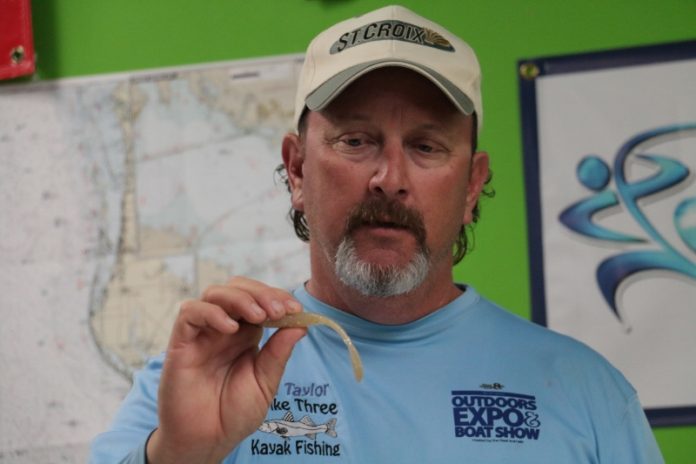From the archives, the departed Terry Tomalin
By Terry Tomalin
All anglers, from space-challenged kayak fishermen to big boat offshore enthusiasts, should properly stock and organize their gear on board for efficient use and in case of emergency, bay area kayak guide Neil Taylor says.
KAYAK GUIDE STRESSES VESSEL ORGANIZATION AS A TOP PRIORITY
St Petersburg- Stop by the Tampa Bay Boat Show at Tropicana Field this weekend and you’ll see the top fishing boats on the market. But every angler knows that it takes more than a sound hull and dependable engine to catch fish. You need a little rigging.
Fishing boats-everything from flats skiffs to center consoles- must have the right equipment. Rod holders, electronics and livewells are all a matter of personal preference. Rigging a boat the right way is as much of an art as it is a science. That’s why even big boat fishermen can learn something from kayak guide Neil Taylor.
“You want your boat to be functional and comfortable, but don’t overdo it,” he said. “You don’t need a lot of unnecessary stuff. It just gets in the way.”
Taylor, a Captain’s Corner Correspondent for the Tampa Bay Times, said today’s paddle fishermen, i.e. kayakers, spend just as much time agonizing about rod holders as their petrol-powered cohorts.
“Those decisions are even more important in the kayak because everything has to be where you can grab it,” he said. “You don’t have the luxury to get up and move around.”
Taylor plans to share his secrets of shallow water angling with fellow fishermen at a seminar Saturday.
STANDARD EQUIPMENT
Taylor’s kayaks always have multiple rod holders. He brings more than one rod in case his primary outfit malfunctions.
Another essential but often overlooked piece of equipment is an anchoring system. Just like a boat-based angler, the kayak fisherman needs to be able to stay in one place when the bite turns on.
Taylor also carries a wade line, so he can get out of the kayak and walk as he sightcasts to redfish. A paddle holder or leash prevents him from losing his most important piece of equipment. And optional outrigger stabilizers make it possible for an angler to stand up in the kayak while casting.
KEEP IT LEGAL
Always bring a personal flotation device. Taylor wears an auto-inflate vest when he fishes alone, in order to, as he puts it, “prevent death.”
Taylor also carries a signaling device, “I attach a whistle to my PFD,” he said. “That way it is right where I need it.”
Many kayak fishermen like to paddle at night, but don’t realize they need a nighttime signaling device- flashlight or headlamp-just like any other boat under way.
OPTIONAL EQUIPMENT
Kayak fishermen need dry bags for all personal gear. Extra rope always comes in handy. Taylor carries a crate full of additional gear, including a first-aid kit, peroxide (for oyster cuts), bug spray, sunscreen, jacket, spare batteries, flare gun, snacks, water, sunglasses case, lens cloth and spare spools for major tangles.
FEELING FANCY
Some kayak fishermen even use live bait. A majority of kayak anglers use artificial lures but there are livewell systems for kayaks. Taylor uses a 5-gallon bucket system that floats next to the kayak, with the help of pool noodle. The water has to be changed frequently but it works.
But he draws the line when it comes to marine electronics such as fish finders. “The best fish finder is your rod and reel with a lure on it,” he said, “Fish finders have applications in other venues but not in Florida west coast kayak fishing.”
Depth finder? “It’s called a paddle,” he said. “Put the paddle over the side, as far down it goes, that’s the water depth.”
Taylor has some advice for every fisherman, regardless of what type of watercraft he uses: “Get organized, Everything should have a place.”
- The Neil Blog - March 23, 2024
- ++++++++++++++++++++++++++++++++++++++++++++++++++++++++++++++++++++++++++++++++++++++++++++++++++++++++++++++++++++++++++++++++++++++++++++++++++++++++++++++++++++++++++++++++++++++++++++++++++++++++++++++++++++++++++++++++++++++++++++++++++++++++++++++++++++++++++++++++++++++++++++++++++++++++++++++++ - June 25, 2023
- Nature Coast:William Toney - December 12, 2021











